Saigon miraculously transcends its density, chaos, smog and construction dust with a welcoming and spirit- charming travellers along the way. It's a remarkable place of history, delicious cuisine and an infectious upbeat energy.
See if you can keep up with the pace of Ho Chi Minh City?
Amidst the intensity, an irrepressible Saigonese energy and optimism endures. Don’t be surprised if you’re charmed by this place, despite your best instincts.
You won't be the first.
Saigon travel highlights
Food - there’s no better place to sample the delicious flavours of Vietnam. And Saigon’s international culinary offerings are impressive too. The expat enclave of District 2 has become a vibrant culinary centre worth checking out if time permits. The newly opened Metro (2024) operates to Thao Dien - the heart of the expat culinary life. Click here for our handpicked list of Saigon's best eating.
A chaotic, fast changing city - Saigon is one of South East Asia’s fastest growing cities. The chaos is exhausting and exhilarating all at once. You'll notice a lot of stalled construction projects and vacant lots on the city centre. Building a city at this clip brings with it many problems.
Alleys and neighbourhoods - For a taste of how the Saigonese really live, head into a local neighbourbood. Cho Lon is one of the biggest Chinatown districts in South East Asia. Its hyperactivity sometimes makes downtown Saigon look mellow. There are temples, shophouses, alleys and a fabulous street food scene.
History - A major centre of French colonial power in the 19th and early 20th centuries, and then the centre of US power during the Vietnam War, Saigon’s history is incredible. Lesser known stories of the city's founding are also fascinating Click here for our list of things to see and do in Saigon. Head out to Cho Lon - Saigon's Chinatown - for another perspective on the city. For a walking tour of history and heritage in Saigon, check out Old Compass Travel.
Disappearing gems - Saigon’s leaders are ripping through the city’s heritage with rapacious determination. In 2023 there are so many vacant lots it sometimes looks like they demolish heritage buildings before they know what to do with the space. Some of these have been vacant or dormant for more than a decade. Check out the cool cafes that are pushing back in old heritage apartment blocks.
Nightlife - Saigon’s mayhem by day morphs by night into a vibrant scene of rooftop bars, from the fancy to Saigon hipster with plenty of texture in between. Hidden cocktail bars abound and the craft beer scene is buzzing too. Click for our handpicked list of Saigon's best nightlife.
Nearby - The former Viet Cong Tunnels at Cu Chi and the Mekong Delta are easy excursions from Saigon
Introduction continued...
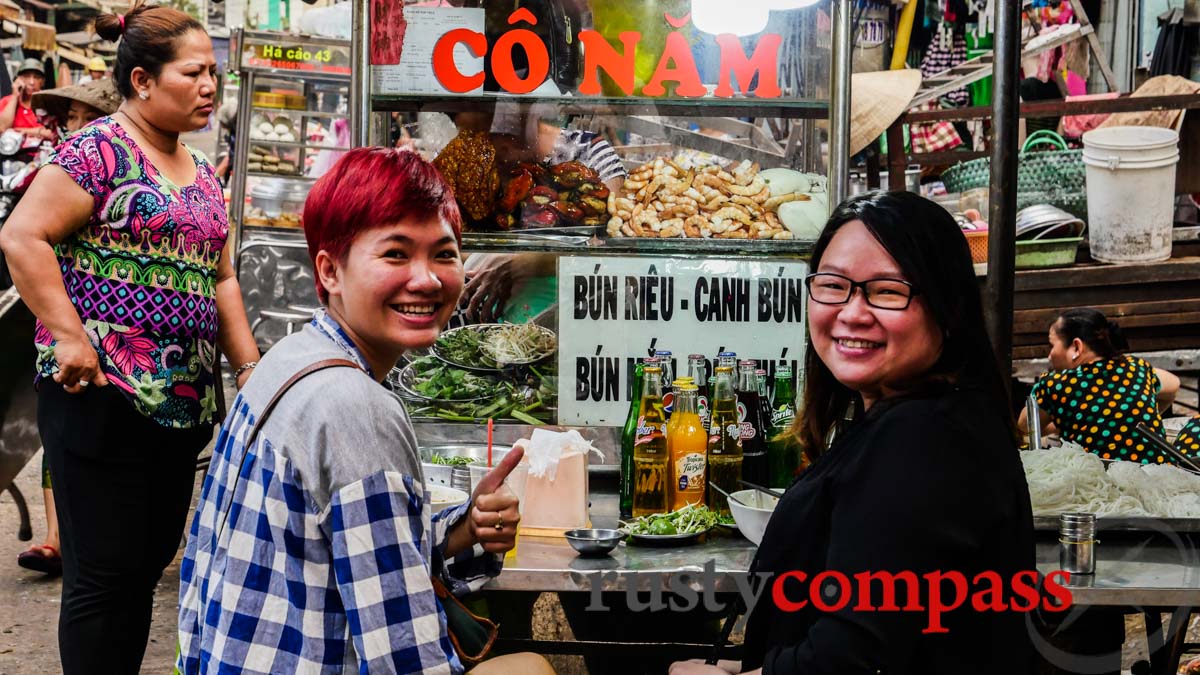
Photo: Mark Bowyer Street food, Cholon - Chinatown
Saigon has spent more than half a century in near constant turmoil - which may explain its residents’ incredible tolerance for disruption and change. French colonials, Japanese invaders, the rabid anti-communist Ngo Dinh Diem and his corrupt American sponsored successors, all had their time here before Ho Chi Minh’s forces took over in 1975 and renamed the city in his honour.
From there it was more than a decade of penury as communist hardliners applied stiff medicine to cleanse the city of its decadent capitalist ways. The result was famine, a massive outflow of boat people and, in the late 80s, a belated decision that perhaps some market forces should be tolerated.
Ever since, Saigon has been at the epicentre of Vietnam’s two decades long experiment with market reform. Its population has swelled, its economy has boomed, corruption has soared and a new class of hyper wealthy have traded hammers and sickles for Hummers and Louis Vuitton.
While Saigon’s cafes are perennially busy serving the city’s new rich, for the majority, life is still a grind of long hours and low wages. But you’ll struggle to find anyone who doesn’t concede that things have improved plenty in the past two decades.
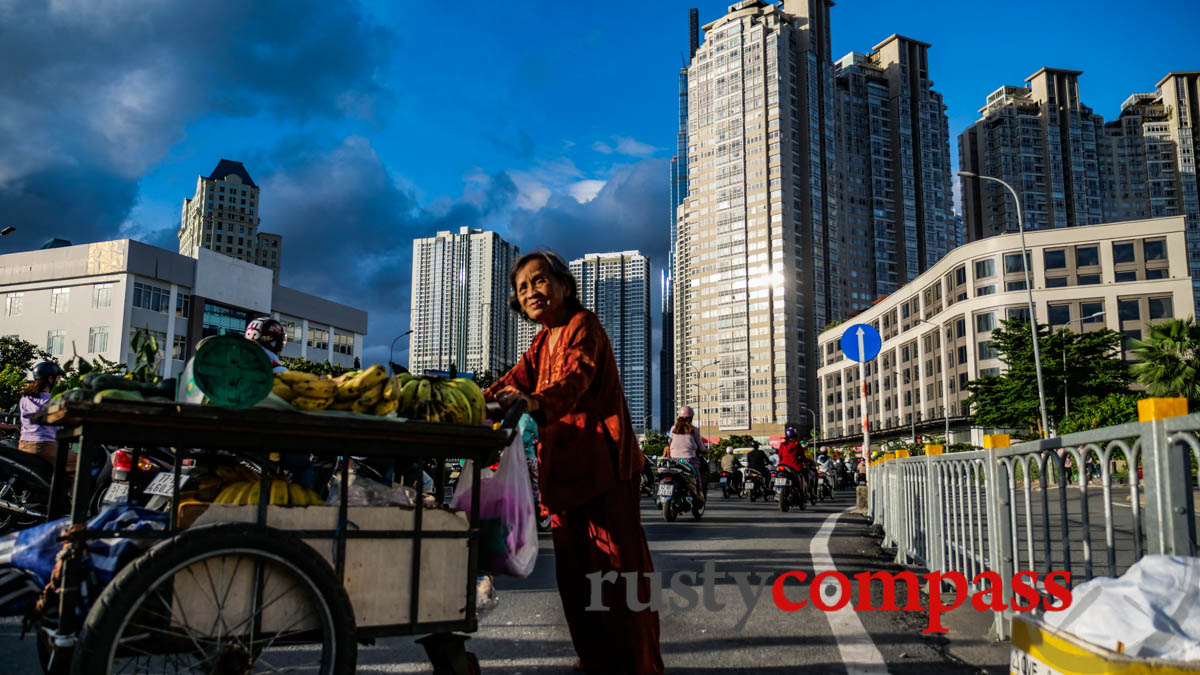
Photo: Mark Bowyer Not everyone is experiencing the boom. Saigon
Saigon may have been known as the Paris of the East in the 50s and 60s, but these days, it’s a bustling architectural shambles.
Some French era boulevards and architectural icons remain. For the most part though, the city’s colonial architectural heritage is going the same way the repressive French colonial administration did decades ago - down. And while modern day Ho Chi Minh City has plenty of attractions, pleasing architecture and public spaces are not among them.
In a depressing binge of self-harm, Saigon's leaders seem determined to cleanse the city of the modest heritage assets still standing. Even Dong Khoi St, the main street since French colonial days, hasn't been spared. Grand old apartment blocks, department stores and shophouses that lent the city some old-world charm, have disappeared. More heritage demolitions are planned.
The demolition of the historic Ba Son Shipyard and its replacement with expensive apartments was an especially tragic planning decision. The city has some of the lowest green space rates in Asia and this was an egregious handing of a public asset to private enrichment. The city's dubious real estate developments have been in focus since one of the world's biggest fraud cases was exposed in Saigon in 2024.
Saigon's colonial past might be disappearing, but juggling past and present is the sport that makes the city such a uniquely compelling place.
The War Remnants Museum, the former Presidential Palace and the Cu Chi Tunnels are compulsory stops on any itinerary. But these relics of a war that put Vietnam on the geopolitical map, seem more consequential to baby boomer tourists than contemporary Vietnamese.
With one of the youngest populations in Asia, Saigon oozes youthful, friendly energy, optimism and good humoured cheek. And it’s Saigon’s rosy outlook that continues to see Vietnam rank highly in global optimism measures.
Even the Vietnamese can’t resist the place. The city is packed with emigres from all over the country - a remarkably large number of them from the proud, victorious capital Hanoi.
Saigon is up there with Asia’s best culinary cities. The delicious distinct flavours that mark out Vietnam’s south, centre and north are all plentifully showcased, as is an impressive turnout of other Asian and western cuisine.
After you recover from the initial shock, it’s easy to be swept up in Saigon’s infectious positive energy. Exploring the the history, the food, the shopping and simply gazing at the constant activity, will easily keep you busy for three days. For more details, read on!
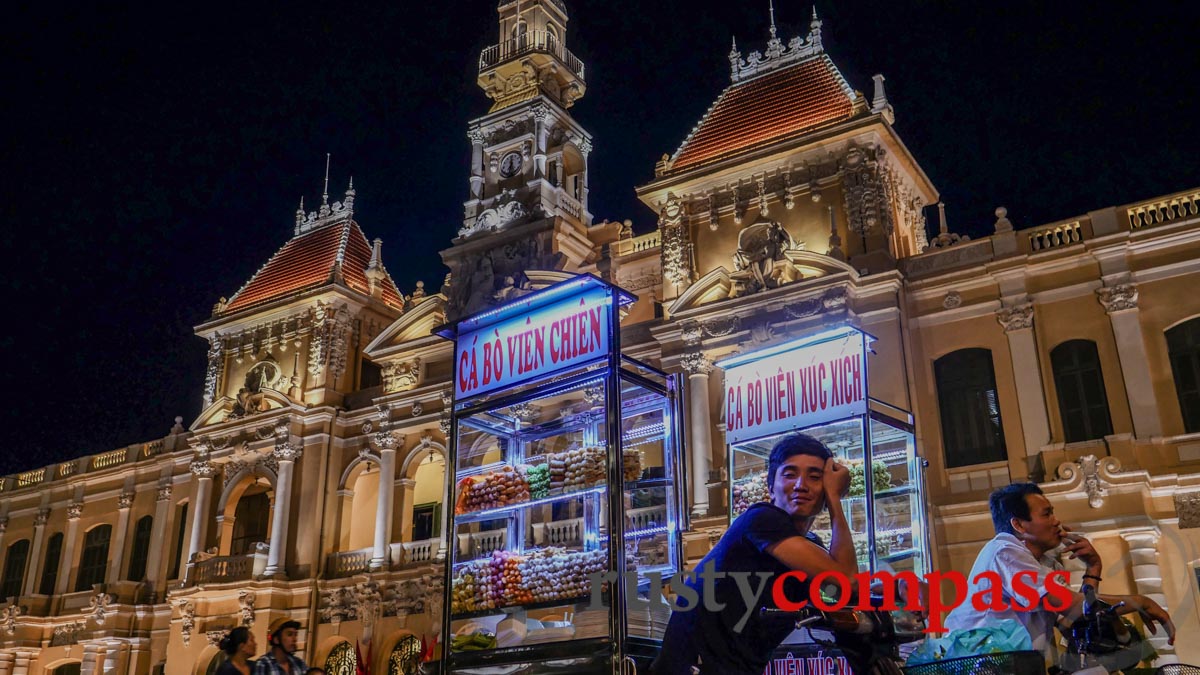
Photo: Mark Bowyer The colonial era People's Committee Building - Ho Chi Minh City
Need to Know - Ho Chi Minh City
A guide to practical things to help you make the most of your time in Ho Chi Minh City
Ho Chi Minh City connections - getting there and away
International Flights - arriving in Ho Chi Minh City
Ho Chi Minh City’s Tan Son Nhat airport is the country’s busiest, serving direct flights from most major Asian cities as well as long haul points in Europe and Australia. It's so busy that it is starting to experience delays with aircraft congestion.
Jetstar, Air Asia, Vietjet and Scoot offer low-cost flights into Ho Chi Minh City from various South East Asian points.
Ho Chi Minh City’s airport immigration arrival process has gone from being one of the worst to one of the best - providing you have handled your eVisa in advance and it's all in order.
See our visa tips and Vietnam travel introduction here.
It’s when you get outside the terminal that things get complicated. For more information on getting into the city, see our “getting around” Ho Chi Minh City page.
Domestic flights
There are four domestic carriers in Vietnam - the national carrier, Vietnam Airlines, Pacific Airlines (owned by Vietnam Airlines), Vietjet and Bamboo Airlines. These carriers operate multiple daily flights from Ho Chi Minh City to major points like Hanoi, Hue, Danang, Nha Trang, Dalat as well as Con Dao and Phu Quoc Islands. Daily flights operate to most other population centres in the country as well. Since COVID the price difference between budget carriers and Vietnam Airlines and has narrowed. The websites of the budget carriers can be annoying too.
Vietjet is the upstart budget operator that’s shaking the market up - though its prices have risen. Bamboo is the latest arrival (pre COVID). We've flown all of them many times. Bamboo seems to have financial problems and recently suspended its international operations.
Rail
Saigon's railway station is around four kilometres from the city centre and is served by taxis. Insist on a metered fare which should cost less than VND80,000 to or from the downtown area. Vietnam's north-south rail network terminates in Saigon.
Rail services operate to and from all major points along Vietnam's coastline. Train travel is especially popular to the beach town of Phan Thiet (accessing Mui Ne - 4 hours approx.) and Nha Trang (8 hours approx). Some travellers choose to take the Reunification Express all the way to Hanoi stopping along the way at points like Nha Trang, Quy Nhon, Danang and Hue.
Road
Saigon is a convenient point of arrival and departure by road to and from Dalat (approx 7 hrs), Phan Thiet (approx 4 hrs), Mui Ne (approx. 4 hours) and Nha Trang (approx. 8 hours) to the north and the popular Mekong Delta towns of Mytho (1.5 hrs), Cantho (approx. 3 hrs), Chau Doc (approx. 5 hrs) as well as road travel to Cambodia (Phnom Penh approx. 5 hrs).
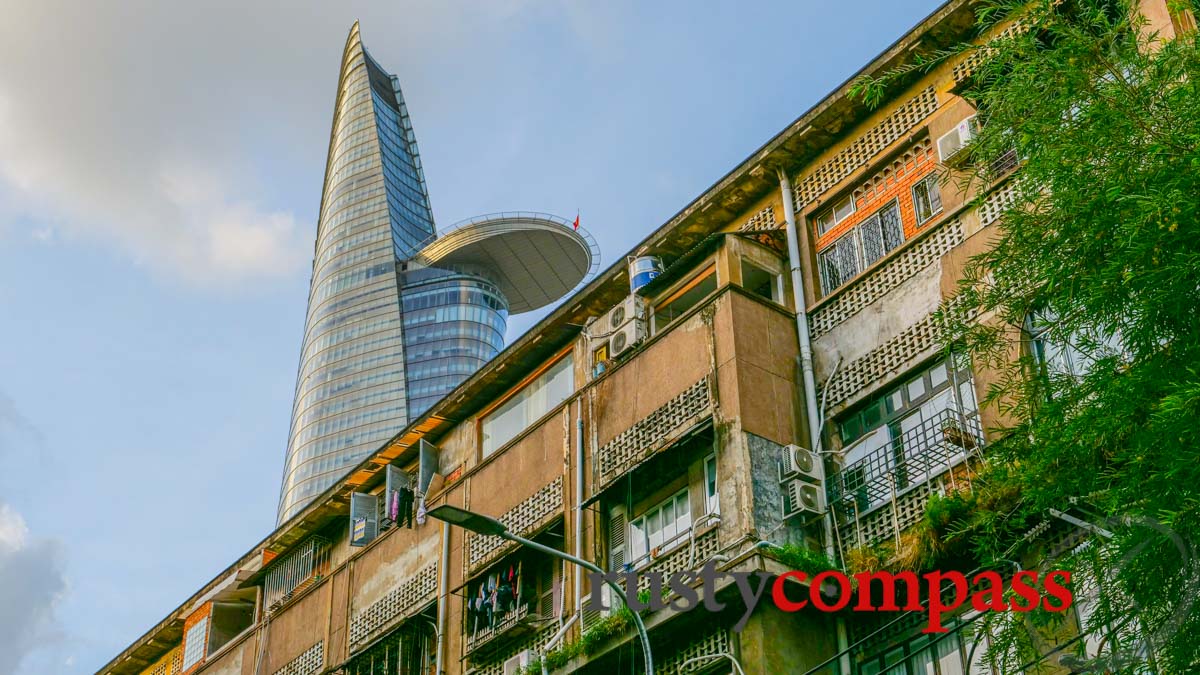
Photo: Mark Bowyer The old is losing the battle with the new in Saigon
Ho Chi Minh City - Getting around the city
The good news about Saigon is that most things you're going to want to see in the city are in a relatively small area that can be managed on foot, by cyclo or by taxi. The bad news is that the Saigon traffic is bad and getting worse by the day. Even short distances can be a headache. And walking can be unpleasant too.
Getting from Ho Chi Minh City (Saigon) airport to the city -
Airport buses and taxis - Ho Chi Minh City
Pre-COVID, Saigon had cheap, good quality airport bus services from both international and domestic terminals. We have yet to find them back in action. The airport is a shambles a lot of the time - especially the domestic terminal.
The Airport bus route was previously numbered 109 and operated in a distinctive yellow bus. It drops off and picks up at selected spots around the city. You may still need a taxi for the last leg to your hotel - even so, you'll be well ahead (if it's operating).... Alas, we haven't located it since 2019 and await its rebirth - it's pretty essential travel infrastructure.
Public buses are operating again (since COVID). They're small with no luggage space and zero information for non-Vietnamese visitors. Very inexpensive but not a straightforward offering for visitors.
If you're taking a taxi from the airport, best to go with Vinasun, Mai Linh or Vina Taxi. Avoid the dodgy guys hanging around outside the airport terminal. A taxi to the centre will cost around 160,00VND (early 2023). The taxi services available in the airport terminal are around double the price of the metered taxis.
For slightly more you can remove the risk of being ripped-off and organise a fixed price private vehicle inside the airport terminal.
Getting around town by taxi and rideshare services
The most exciting development in getting around in Saigon for travellers has been the recent launch of EV rideshare under the Xanh SM brand. This is an EV rideshare service of excellent quality, that's great value for money AND good for the environment. Download the app Xanh SM app to access the service. We found it worked well on our recent visit - it was the best all-round rideshare experience of my travelling life anywhere in the world! This may change as the service becomes more popular. In November 2023 it was outstanding!
Taxis and rideshare are inexpensive and convenient in Saigon - providing you avoid dodgy taxi operators. Our favourite taxi companies are Vina Taxi (yellow colour) Vinasun (white with green stripes) and Mai Linh. There are other newer companies that are also OK. Avoiding the fakes and the copies is the big challenge.
Uber withdrew from Vietnam years ago in a dubious deal with Grab that merged the two rivals. Consumers and drivers were the losers. Grab is the main rideshare player in many Asian markets as it is in Vietnam. GoJek and Be are other rideshare players.
Grab also offers motorbike taxi services.
To use Grab ride-share, download the Grab app.
A new service called Xanh SM offers brand new EV taxis around the city. You use the Xanh SM app to manage these too.
Ho Chi Minh City Metro Service
In 2024, Saigon's long-awaited Metro service finally commenced operation. For visitor, this means that for less than 50 US cents you can travel in comfort to District 2 - the expat enclave that is increasingly the home of international cuisine in the city. Apple and Google Pay are accepted on Saigon's Metro system.
Dodgy taxis in Saigon
Beware of dodgy taxi companies that congregate around tourism hotspots like the War Remnants Museum, Ben Thanh Market and late night venues like - especially in the backpacker precinct, preying on travellers not aware of the scams.
Apart from being particularly nasty, their fares are often two, three or four times the going rate. The dodgy companies will tend to use old small vehicles so look for newer larger taxis.
Getting around Saigon on foot
Walking is possible in Saigon. But it can be difficult in busy areas. Motorised transport rules - on the road and on the pavement. It means you’ll find the roads packed with motorcycles, cars and trucks and the footpaths handle the overflow from congested streets. It’s not unusual to find motorcycles mounting the footpath and riding at speed past pedestrians and between the millions of bikes parked on pavements.
Weaving your way through this is fun for about an hour. Then it becomes stressful and can consume a lot of energy.
Saigonese drivers have little regard for pedestrians and will depend on you getting out of their way in all situations - whether you're on the road or the footpath - so be forever vigilant.
Many travellers assume that miraculously the traffic chaos always works out. It doesn't. Saigon's roads kill and maim every day.
Crossing the road will prove to be a big challenge. Look closely at oncoming traffic, remember that there may well be riders going in both directions in a particular lane and never assume that cars and bikes will obey red lights or pedestrian crossings.
Many of the streets in the centre of District 1 are some of the least congested so negotiating these can be easier.
Be aware that many travellers are robbed while walking on sidewalks and crossing roads. Hold your cameras and possessions tight.
Getting around by Cyclo
Saigon's cyclos are facing extinction as the city's motor traffic takes full control of the roads. There are a few proud survivors around major tourist spots and they offer a unique perspective on the city's chaotic traffic.
Be sure to clearly negotiate a rate in advance and remember that in these days of high inflation in Vietnam, a cyclo is usually a more expensive way to get from point to point than a taxi.
Some travellers have reported nasty experiences with cyclo drivers threatening them and grossly overcharging. Be careful and be absolutely clear on your pricing. Cyclos seem to be demanding around 70,000 100,000VND per hour these days.
Getting around Saigon by Xe Om - motorcycle taxis
Motorcycles taxis (known as xe om which translated literally means "hug bike" as you have to hold on to your driver to stay on) took over from cyclos in the 90s and remain popular. The introduction of mandatory helmets at the beginning of 2008 made them a little less attractive to some but they are still a quick, fun and occasionally hair-raising way to get around.
The arrival of Grab and rideshare services has mostly wiped out the private xe om rider. These days they're most likely to be wearing the distinctive green vests of Grab.
If you happen to negotiate a ride directly, like cyclos, make sure you name your price first.
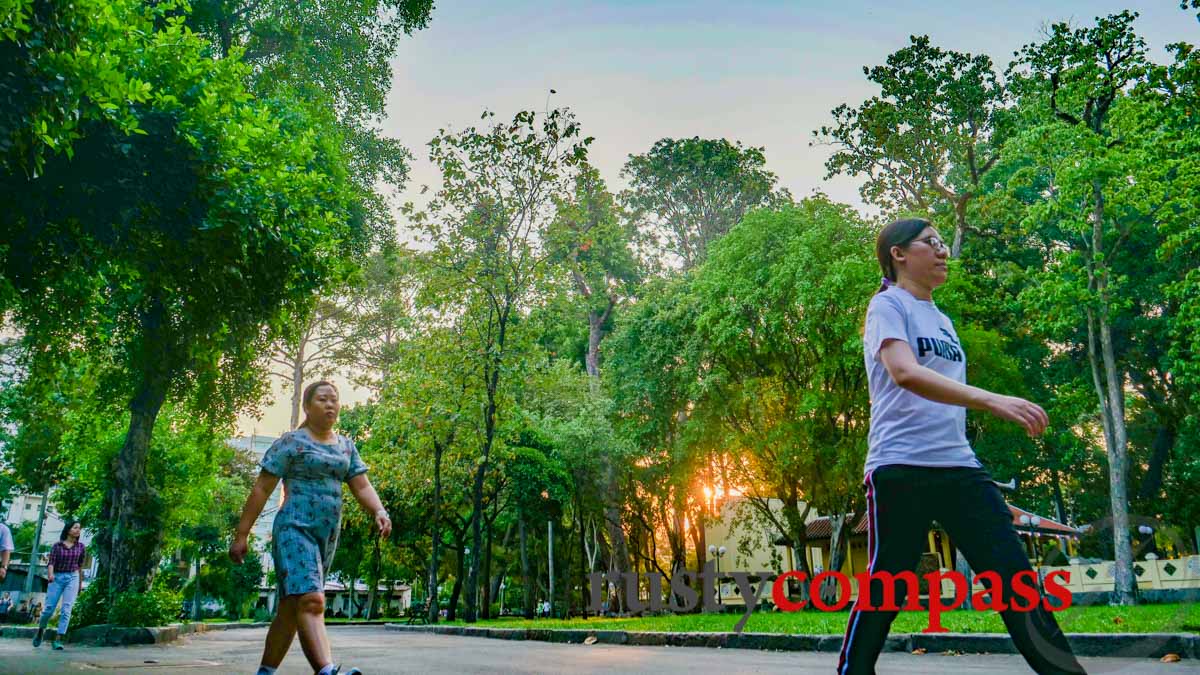
Photo: Mark Bowyer Getting some exercise in one of Saigon's downtown parks
Ho Chi Minh City - Health and Safety
Information fot travellers about scams, crime, safety and health in Saigon (Ho Chi Minh City).
Safety
Saigon is a relatively safe destination for travellers. Violent crime against foreigners is rare. There are some hazards worth noting though and these problems seem to be getting worse.
As a traveller, you’re most likely to be scammed when travelling in a taxi, a cyclo, or responding to inexplicable offers of hospitality from random people on the street or in bars. Use caution in all circumstances and don't let your positive view of humankind relieve you of your commonsense.
Favour newer looking taxis and our recommended companies (see “getting around” above) and try and get a sense of the geography yourself (pick up a local SIM card with data and use the GPS on your smartphone).
Common scams and crimes in Saigon:
Bag and phone snatching: Travellers frequently fall victim to bag and phone snatchers on motorbikes when crossing the road. This is the most serious and most common problem to befall travellers. We hear of it constantly. Be very careful with your valuables. Cameras are also prized by thieves.
Cyclo, xe om, taxi intimidation: At the completion of a ride, a cyclo, xe om or taxi driver may insist on a large payment (often as high as US$200) and threaten you if you don’t comply. These problems seem to be most common when travellers don’t pre-agree a price.
There’s something to be said in getting some casual happy snaps with your cyclo driver if you’re doing a longer tour with them.
The tragedy of these incidents is that they tar the entire cyclo / xe om / taxi fraternity - most of whom are perfectly decent. Be nice to your cyclo driver and you'll more than likely find the courtesy will be reciprocated.
Taxi intimidation: Saigon’s best taxi drivers are good by any standard. Unfortunately, the worst drivers are also worthy of note.
Part of the problem is the peculiar arrangement that sees dubious taxi companies getting the best spots at places frequented by vulnerable tourists. They even seem to have privileged access to the airport
The other problem is that many of the most disreputable taxi companies copy the names and logos of the more reputable companies. An example is Vinasum taxis trading off the good name of Vinasun taxis.
Keep your wits about you and remember that the more modern a taxi looks, the more reliable it’s likely to be. Taxi issues definitely become a bigger problem the later it gets in the evening. Be careful rather than paranoid.
The success of Grab and other rideshare operators has reduced traveller exposure to taxi risks.
Random tour guides met on the street: A number of travellers have been persuaded by young men on the street posing as tour guides to take ‘unofficial” tours at an agreed price. At the end of the tour, the guide threatens the tourists and demands far higher payment.
Money changers on the street: These are as risky in Vietnam as everywhere else in the world.
Late night violence: As with all big cities, the later you’re out in Saigon, the more likely you’ll witness or be a victim of crime. Stories of late night violence from the Pham Ngu Lao and Bui Vien backpacker’s area are common though probably no more so than in other international cities. One difference is that if you end up in a serious dispute with one of the bars, you may find a large number of local men throwing bottles and tables at you. It can get very nasty. Some of the staff in bars along Bui Vien St seem to relish the occasional fight. Bottles, chairs and tables are the preferred weapons and people can get seriously hurt.
Petty crime including lost cameras, bags and wallets are also common in the late hours.
If you’re a victim of crime, the Vietnam police experience is likely to be unsatisfying. Reporting a crime can be a serious hassle and empathy is not the strong suit of the local constabulary. Even lodging a statement can be a hassle. Persist though, you'll need some documentation for your insurance.
Health
Make sure you have good travel insurance that includes full evacuation in the event of serious illness or accident. While Saigon is home to Vietnam’s best equipped hospitals and clinics, they’re still behind the best international standards. Regional centres like Singapore, Hong Kong and Bangkok are also superior in both expertise and equipment. Seriously ill patients are commonly airlifted to Singapore, Bangkok and Hong Kong.
Here is a list of international medical facilities in Saigon (Ho Chi Minh City):
1. Family Medical Practice HCMC
Diamond Plaza
34 Le Duan Street
District 1
Ho Chi Minh City, Vietnam
Main Tel: +84 8 3822 7848
Fax: +84 8 3822 7859
Email: hcmc@vietnammedicalpractice.com
2. FV Hospital
6 Nguyen Luong Bang St., Saigon South (Phu My Hung), Dist. 7, HCMC
Tel: (08) 54 11 33 33
Fax: (08) 54 11 33 34
Email: information@fvhospital.com
FV Sai Gon Clinic
2nd Floor, Citilight Tower, 45 Vo Thi Sau St., Dist. 1, HCMC
Tel: (08) 62 90 61 67
Fax: (08) 62 90 61 68
Email saigonclinic@fvhospital.com
3. International SOS Vietnam, Ltd.
167A Nam Ky Khoi Nghia St, D3
Ho Chi Minh City, S.R. Vietnam Vietnam
Tel +84 83 829 8424
http://www.internationalsos.com/en/about-our-clinics_vietnam_3536.htm
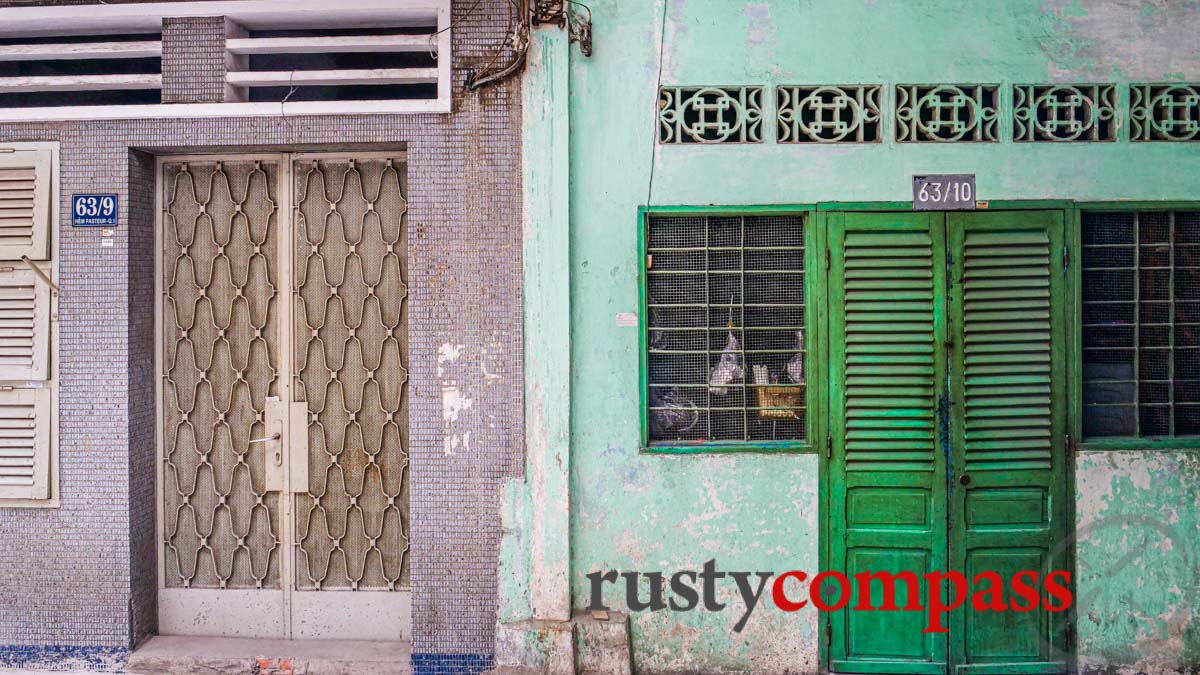
Photo: Mark Bowyer Saigon shapes and shades.
Ho Chi Minh City - internet, mobile, ATMs and credit cards
Cafes, restaurants, bars and hotels offer free wifi pretty universally around Saigon. Speeds are usually OK too.
3G and 4G services are also good and inexpensive. You can pick up SIM cards on arrival at the airport. Viettel is said to have the best national coverage in remote areas. Vinaphone and Mobifone offer good coverage too.
ATMs accepting international cards are everywhere in Saigon. Credit cards are increasingly accepted and Apple and Googe Pay are increasingly widely used. Amex less so.

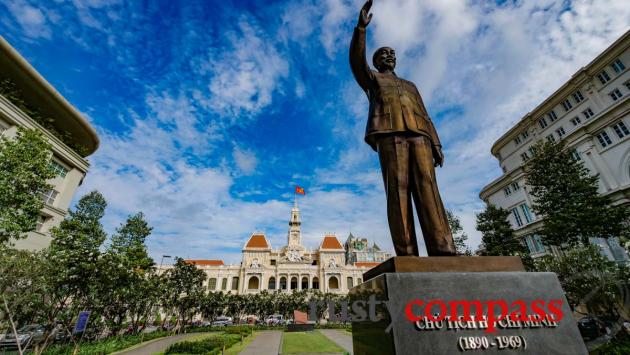
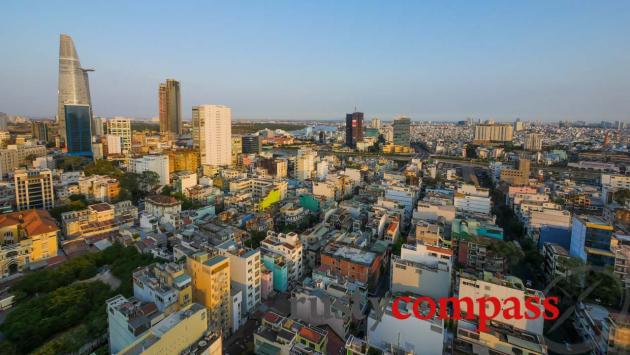
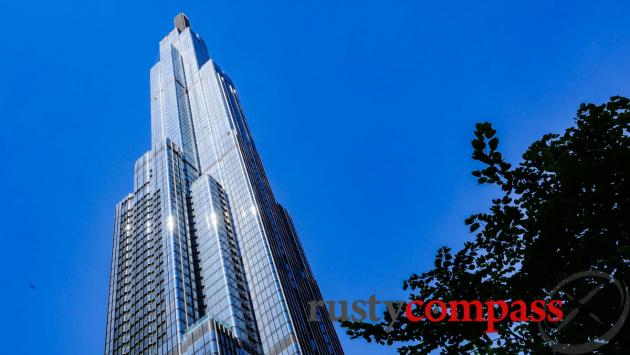
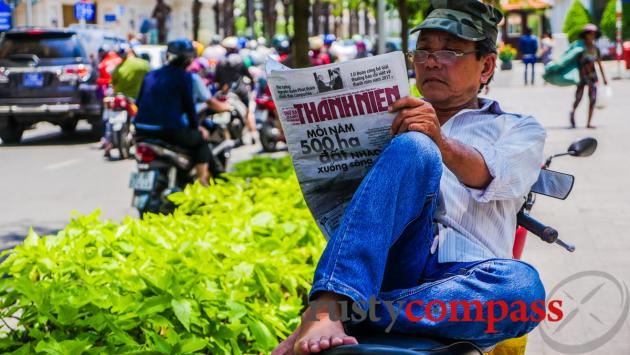
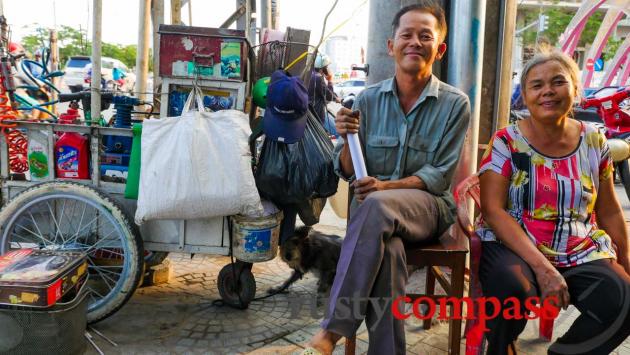
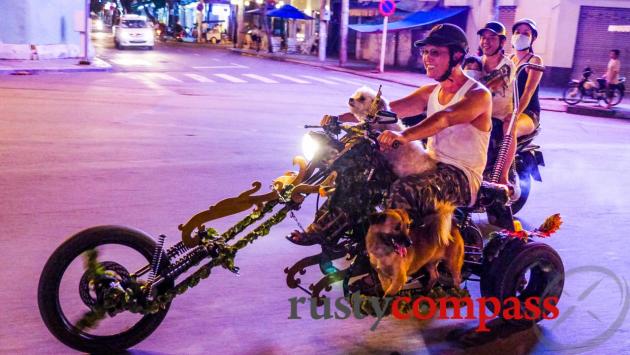
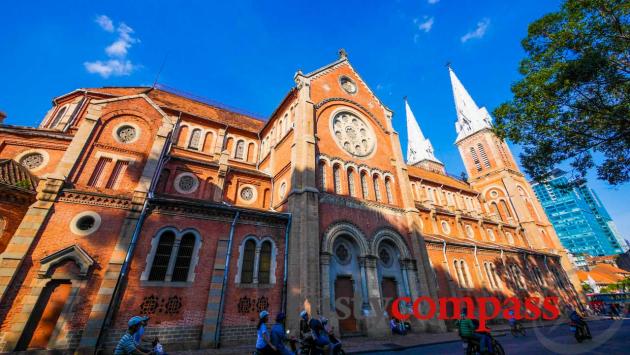
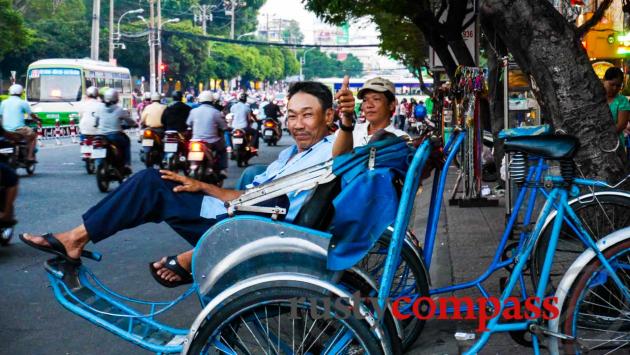
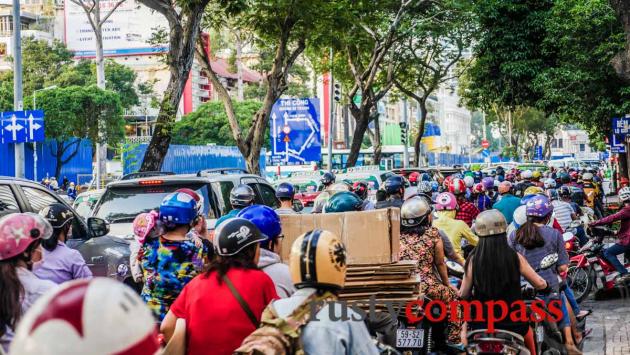
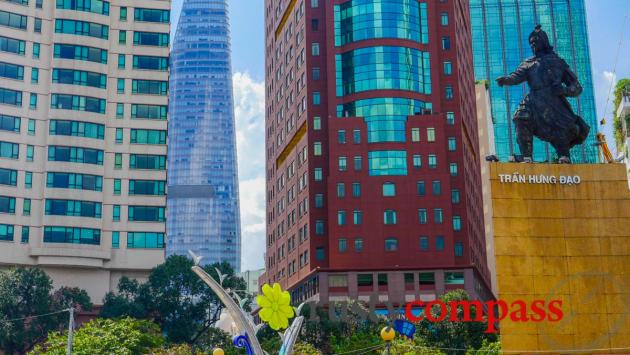
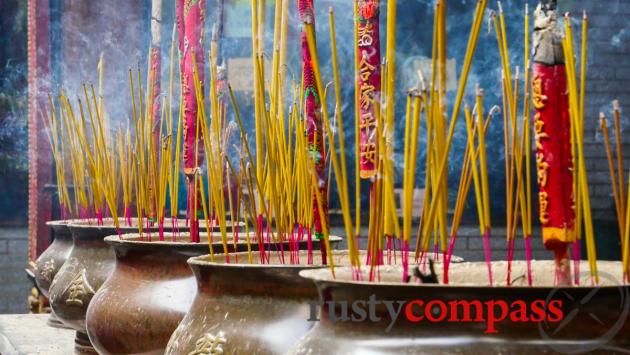
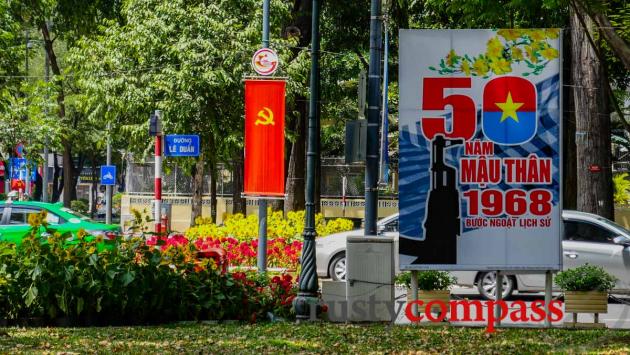
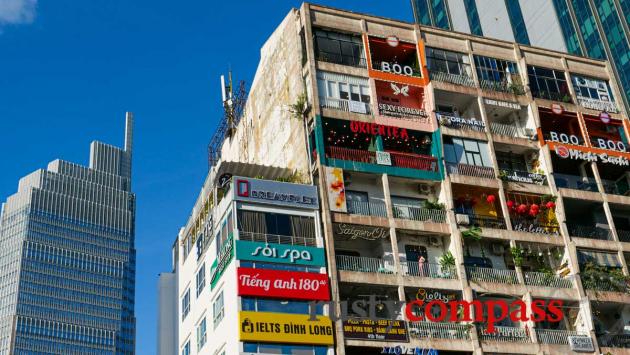






Twitter: @rustycompass
Rusty Compass is an independent travel guide. We’re focused on providing you with quality, unbiased, travel information. That means we don't receive payments in exchange for listings and mostly pay our own way. We’d like tourism to be a positive economic, environmental and cultural force and we believe travellers deserve disclosure from publishers. Spread the word about Rusty Compass, and if you're in Saigon, pop in to The Old Compass Cafe and say hi. It’s our home right downtown on Pasteur St. You can also check out our unique tours of Ho Chi Minh City and Sydney at www.oldcompasstravel.com Make a financial contribution using the link below. Even small amounts make a difference. Thanks and travel well!